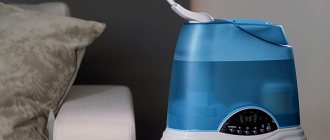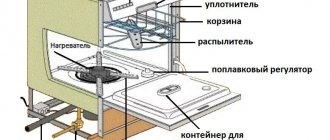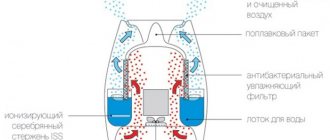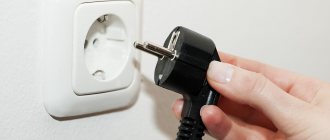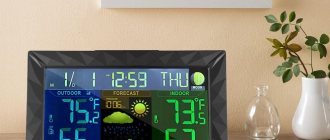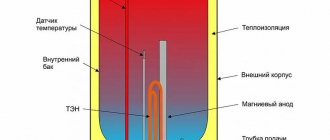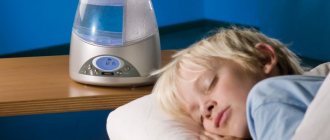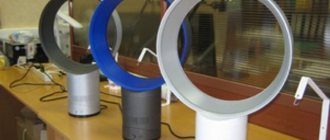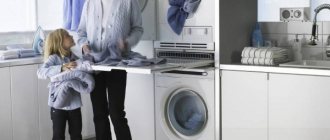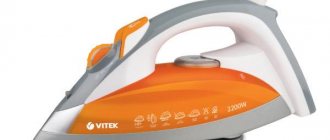Design and principle of operation
The climatic device consists of a container in which the main supply of water is located, and the base of the device, with an emitter located in it. A dosing valve is installed in the main water reserve tank, which serves to maintain the required water level in the compartment with the emitter, preventing excess. In addition, a fan is installed in the humidifier to blow out water sprayed by the ultrasonic element.
Almost every modern humidifier has an electronic control and a hygrostat to accurately measure humidity levels. Many manufacturers equip their devices with ionizers, various filtration systems and many additional programs to make using the device more comfortable.
The operating principle of an ultrasonic humidifier is easy to understand.
- The main unit of the device is the emitter. It looks like a washer made of piezoceramic ceramics, with silver-plated electrodes exposed.
- When alternating current is applied to it, this element begins to vibrate at an ultrasonic frequency. When a certain power is reached, the vibration speed increases to such an extent that it begins to break the surface of the water into tiny particles.
- The water, converted by the emitter into an aerosol in the chamber above the ultrasonic element, is blown out by an installed fan. Water mist fills the room and increases air humidity levels to user-set limits.
- The hygrometer installed in the device will show the relative humidity of the air, and the user always has the opportunity to stop the device from executing the program or increase the power of the humidifier if there is insufficient humidity.
- After the device reaches the required humidity values, it stops and is in standby mode. After the moisture content in the room air decreases, the device automatically turns on and the cycle repeats.
The role of the humidifier
Before you make a humidifier at home, you need to understand why it is needed in general. It is especially difficult to maintain the air of normal humidity in a room in winter, since centralized heating dries it out, and breathing dry air is fraught with consequences. These include respiratory tract disease, allergies and other troubles.
Do-it-yourself air humidifierIt is especially important to have it in a house where there is a small child, since his body is still imperfect and requires special conditions for normal growth and development.
All humidifiers perform one important function: they maintain the humidity level in the room at 40-70%, which is considered optimal for humans.
Ultrasonic
- with this method of humidification, the role of an evaporator is played by a plate vibrating at an ultrasonic frequency - due to this, the water falling on it is sprayed into a fine mist. This is the most popular operating principle, and it is also considered the most suitable for home (household) humidifiers. The reason for this is a number of advantages. Firstly, the “cloud” is at room temperature and the risk of getting burned by the steam is zero, which is especially important if there are small children in the house; however, some models may provide the ability to heat the steam (see “warm steam”). Secondly, ultrasonic models have good efficiency and performance with low power consumption. Thirdly, ultrasound is not audible to humans, and the main noise is created by the fan - and the level of this noise is low. Fourthly, devices of this type can be made lightweight, compact and convenient for travel. The disadvantages of ultrasound include the fact that it “evaporates” not only water, but also salts dissolved in it. In practice, this means that you need to use well-purified water for work - otherwise a difficult-to-remove white coating may appear on objects in the room.
General rules for operating air humidifiers
Before connecting the humidifier to the network, you need to check the tightness of its housing and cord. If the housing is cracked or the cord is damaged, the product cannot be connected to the outlet. If the device fails, you need to contact a service center.
It (like any other equipment) is guaranteed. But the warranty will be void if you repair the humidifier yourself.
Features of activating the humidifier
To turn on the humidifier, you must first connect it to the power supply by inserting the plug into the outlet. Then (depending on the type of device) you should press the on/off button on the unit body or activate the device using the remote control.
When the humidifier is turned on, the green indicator on its body lights up, and when turned off, the red icon lights up
All additional functions of the humidifier are indicated on the display after switching on. To activate them, press the desired button on the LCD screen.
Features of using different types of humidifiers
The humidifier should be placed on a dry and level surface. The machine must be in a stable position, otherwise it may tip over during operation. Tilt of the device may interfere with its normal operation.
You should not install the humidifier at a slight angle, even if it is well secured.
Before turning on a traditional type of humidifier, you need to place a filter in the water tray, attach the lower part of the device and secure the housing.
Then you need to fill the tank with distilled water and close the lid. After this, you should place the container on the lower part, turn on the device and select the most suitable mode using the switch on the body of the product.
If you need to turn on the steam humidifier, you should first fill it with water, keeping an eye on the liquid level indicator in the device. Then you need to turn on the device and select the operating mode.
During operation, the green indicator on the device body will light up. When all the water has evaporated from the tank, the indicator will turn red and the unit itself will automatically turn off.
When using an ultrasonic humidifier, one day before turning it on, you need to place the demineralization cartridge in a container with clean water. The next day, you need to fill the tank with water, close it with a lid and insert it into the housing. After this, you should install the part with the sprayer and turn on the unit.
Ultrasonic humidifiers are among the most modern and functional technology, and therefore they are often used in offices and other commercial premises.
If everything is done correctly, the green indicator on the device will light up. Then you need to select the appropriate mode and adjust the desired humidity level. When this parameter is reached, the humidifier will turn off on its own.
Safety precautions when working with a humidifier
Before turning on the humidifier, you should read its operating instructions. It provides general recommendations for using the device.
However, when using any type of humidifier, it is prohibited to:
- add liquid to the reservoir of the switched on device;
- use dirty water;
- rearrange the device plugged into the outlet;
- add flavoring agents directly to the water (there is a special compartment for this);
- pour water into the humidifier through the hole intended for the release of water vapor;
- block this hole, etc..
The operating time of the device depends on its design features. Steam humidifiers can achieve the desired level of humidification in just a couple of hours. But traditional models usually work slower and sometimes saturate the air with moisture for 10-12 hours.
Information on how long and at what mode the humidifier should operate in order to achieve the optimal level of humidity in the room can be found in the instructions.
Water is heavier than air, and moistened air currents automatically go down, and therefore it is better to install the device on a small elevation from the floor (for example, on a stool, coffee table, wall shelf or bedside table). Devices with large tanks (8-9 l) can be placed on a cabinet or high shelves.
When choosing the optimal location for installing a humidifier in a living room or office, you need to unplug it from the socket.
A small humidifier should be at a minimum distance of 50 cm from the floor. If you place the device on the floor, a small puddle will soon appear around it.
Due to the nature of its operation, this device should not be placed next to:
- electrical appliances;
- walls (otherwise unsightly stains may appear on the wallpaper);
- upholstered furniture;
- books and clothes;
- central heating radiators (on the contrary, they dry out the air and can negate the benefits of using a humidifier).
The distance from these items to the humidifier should be about 30 cm so that moisture does not settle on them. Fine particles of water (after all, steam is one of the physical states of water) that get on technical devices can disrupt the operation of any equipment.
There should be enough free space around a household humidifier with any operating principle for normal air circulation
If there is an aquarium in the room, then you should not place a humidifier next to it. This is simply impractical, because water also evaporates from the aquarium, humidifying the air. Those. a double humidification effect is created, which can also negatively affect the indoor microclimate. Due to too much humidity in the apartment, pulmonary diseases worsen, and mold appears on the walls.
If there are children or pets in the house, the device should be placed out of their reach. In this case, it would be appropriate to install even a small air humidifier on a cabinet or high shelf.
Sometimes something like a plastic grill or fence is designed for the humidifier to prevent small children, dogs and cats from reaching it.
If there are no small children or pets in the apartment, then the humidifier can be placed in the middle of the room at some distance from the furniture. But the device should not interfere with free movement.
It is also important to remember that the humidifier is powered by electricity, so it must be installed near an outlet. If possible, you should avoid using surge protectors, extension cords and adapters, since these are additional connections and unnecessary contacts.
Difference from a steam generator
There are two types of household humidifiers. Some work by increasing the evaporation area, others by heating the liquid until steam forms. In both cases, water evaporation occurs naturally; we won’t talk about steam generators today.
Most modern household appliances use a piezo emitter - a plate that vibrates at an ultrasonic frequency. The principle of evaporation here is this: water is broken into very small particles, a fine suspension, which cannot “stick together” back and continue to exist in the form of water vapor. The advantage of dispersed humidifiers is low energy consumption and the almost complete absence of scale in the device itself, which affects its durability.
Ultrasonic humidifier: disadvantages and advantages
Automatic devices are equipped with sensors whose functionality includes diagnosing the conditions in the room and selecting the appropriate program to maintain a comfortable microclimate in the room. Filtration systems are built into the air humidifier, which allows you to reduce the concentration of dust in the room. Some devices are equipped with water filters. They remove unwanted salts and other impurities from tap water.
Advantages of climate control units
Ultrasonic air humidifiers have a number of obvious advantages, which are worth dwelling on in more detail:
- minimal noise during operation;
- water is sprayed into microparticles, creating a “cold fog” effect;
- high ergonomics, compact dimensions;
- presence of a built-in hygrometer;
- maintainability of the device.
Disadvantages of ultrasonic devices
Like any technology, climate solutions also have certain disadvantages. Since an ultrasonic humidifier often works with untreated water, a white coating often forms on the furniture around the device - this is the main “disease” of devices of this type. We are talking about salts present in water. When the “cold fog” evaporates, they settle on the furniture, floor, and objects in the room.
As for the ultrasonic emitter itself, it is absolutely harmless to the health of humans and four-legged children. When you inhale steam containing salt particles, they easily enter the lungs. They are invisible to the body of a healthy person, but allergy sufferers and asthmatics will have a hard time. In especially severe cases, attacks of suffocation occur.
It is useful for people with respiratory problems to stay in the room where the device is installed, because the danger of drying out the nasopharyngeal mucosa is eliminated.
The best ultrasonic air humidifier will also have a place in a child’s room, because such a useful device should certainly be in every residential building. The device normalizes respiratory function, saturates the blood, internal organs and brain with oxygen. In a room with optimal humidity, breathing is easy and simple, and sleep is deep and sound.
Why are humidifiers needed?
An air humidifier is a unique device. It is necessary to create an optimal indoor microclimate.
Other important functions of this device include:
- maintaining the required level of humidity in the room;
- elimination of static electricity charges (they can arise in dry air);
- cleaning the air from dust and microparticles of dirt, etc.
Air humidifiers prevent the development of various diseases of the upper and lower respiratory tract. They have a beneficial effect on skin, hair and nails, preventing the aging process. These devices can also be used to prevent nosebleeds in adults and children.
Rules of use and care
You will have to say goodbye to some of the advantages of a ultrasonic humidifier if you do not comply with the operating requirements. Do not forget that all humidifiers are energy-dependent devices that operate on an electrical network, so they are a priori dangerous if handled carelessly.
The best place to install a humidifier is a free space in the center of the room. This way the moisture will spread evenly around the entire perimeter of the room.
Some operating standards are prescribed by the manufacturer, others are well known and do not require reflection in the instructions.
So, in order for the humidifier to work for a long time, properly and without causing trouble, follow the rules:
- Remove the tank to fill with water only when the power is turned off.
- Use filtered water. If the device has filters, change them on time.
- When using hard water, deposits are deposited inside the structure. To prevent this from happening, the device is regularly cleaned with a solution of citric acid (per 1 liter - 30 grams of dry matter).
- In addition to citric acid, it is allowed to use vinegar, special products for plastic, soap solutions without antibacterial inclusions, and anti-scale agents.
- For reading, you cannot use alcohol solutions, acid other than citric acid, chemical solvents, oils, bleaches, abrasives, or hard brushes. Washing parts of the device in the dishwasher is also prohibited.
- The body of the device is wiped with a micro-lint cloth soaked in water, the tank is removed, soaked and wiped, and the internal elements are also soaked in the solution for 15 minutes.
If the device has an electronic display or indication, carefully monitor the signals and follow the prompts. Manufacturers have tried to make it as comfortable as possible for users of UV devices to use them.
If the device breaks down and you cannot fix it yourself, we recommend contacting a service center. The warranty on some devices is 1 or 2 years, during which time you are required to repair or replace the equipment free of charge.
Why do you need a humidifier?
When the heating season begins, you need to monitor this even more carefully. After all, due to heating, the air is additionally dried out, which negatively affects well-being.
More precisely, when heating devices operate, the relative humidity inside the room can decrease by up to 20%. For comparison, in the Sahara this parameter is at least 25%. That is, we can say that many people work in conditions that can be compared to desert conditions.
Of course, to solve this problem, you can use “grandmother’s” technique - hang wet laundry throughout the house or apartment. But the obvious disadvantage of this method is the inability to maintain the required humidity.
To ensure maximum performance of the humidifier, it should be turned on in an enclosed area.
The best solution would be to purchase a specialized device - a humidifier. With its help, you can easily maintain a certain humidity in both office and residential areas. Such a device will help create a truly favorable and comfortable microclimate for humans.
A distinctive feature of modern models of air washers is that they automatically maintain the user-specified humidity level. This increases the efficiency and safety of operation of such a device.
If you spend money on such a device, then after some time you will notice that household members, in particular children, get sick much less often. At the same time, the skin will become smoother and silkier, which allows you to slightly slow down the aging process. In addition, viral activity is greatly reduced in humidified air.
Dry air can cause allergic reactions.
Due to low humidity, dust particles quickly move into the respiratory tract and irritate them
Optimal humidity is important not only for people, but also for wooden or paper products.
That is, by purchasing an air washer you can protect furniture, books, paintings, frames, documents, parquet, musical instruments and much more from drying out, cracking and irreparable damage.
Ultimately, normal humidity in the room will have a beneficial effect on the plants. Indeed, in most cases, representatives of the tropics stand on the windowsills. Dry climates have a detrimental effect on such plants. But if an optimal microclimate is created, they will grow more intensely, bloom more profusely and not turn yellow.
Existing types of air washers
Before you go to the store, you need to understand in detail the existing types of devices - there are thousands of options on the market, differing in power, the presence of any additional functions and, of course, price.
How to decide on the type of equipment?
The first thing you should pay attention to when choosing such household appliances is the type of humidifier. All models on the market can be divided into the following categories:
- ultrasonic;
- steam;
- classic;
- sinks;
- climatic complexes.
Each type has its own advantages and disadvantages, which must be taken into account when choosing. Moreover, each of them works according to its own principle, so some models are not recommended for installation in rooms where children live.
Ultrasonic humidifier options
The most common are devices that evaporate water due to ultrasonic vibrations of a very thin membrane. It was the use of innovative technologies in the design process of these elements that brought the devices recognition from millions of buyers around the world.
The operating principle of ultrasonic devices: water becomes steam due to high-frequency vibrations. That is, air is sucked from the room, after which it passes through the device and is saturated with liquid. Then it returns to the living space, but in the form of damp fog.
The resulting air does not heat up. Therefore, you don’t have to worry about getting burned by it. Accordingly, ultrasonic humidifiers are completely safe for small children, which makes it possible to install them in a children's room.
Devices that evaporate water using high-frequency vibrations can be used not only in residential premises, but also in greenhouses and winter gardens
If you have antiques at home that require special, careful care, then such humidifiers will be the optimal solution. In this case, antique furniture, jewelry, parquet flooring, musical instruments and much more will not be affected by dry air.
Among all the devices on the market, ultrasonic devices stood out due to their following advantages:
- high technology makes their operation safe. The device will automatically turn off if there is no water in the tank or if the lid is not tightly closed;
- low noise will not interfere with watching a movie or relaxing;
- a rotating sprayer evenly humidifies the air in the room;
- the built-in hygrostat automatically switches on/off, maintaining a comfortable microclimate and saving energy;
- The presence of an effective filter cartridge allows you to purify the water and avoid the appearance of white deposits on furniture and interior items.
For convenience, many models are equipped with a special indicator that shows the current level of air humidity.
The devices also differ in how they are controlled. Some of them are activated using a rotary knob, while others are activated by pressing touch buttons.
The only disadvantage of ultrasonic devices is their high cost. But small size, high efficiency and economy completely eliminate this disadvantage
How to properly use a humidifier in an apartment or house?
Air humidifiers have long become common household appliances that can be found in almost every home. However, the key to obtaining the desired result - a favorable microclimate in the room - is the correct operation of the device.
In this article we will tell you how to properly use a humidifier in your apartment and at home, as well as how to fix minor malfunctions and failures yourself.
Design and principle of operation of an air humidifier
Cold (classic)
Cold (classical) type devices are provided with a container for liquid driven through evaporators. At the same time, special fans draw air into the device and release it into the room already humidified.
Also, classic humidifiers are often used in aromatherapy - just a few drops of essential oil can instantly spread throughout the entire room and fill it with an incredible smell.
Such devices operate automatically via the network, and when the humidity reaches 60%, they turn off on their own.
Steam
The operating principle of steam humidifiers is based on preheating water: using two electrodes, the liquid is brought to a boiling point and converted into steam, spreading throughout the room. This process is repeated as long as there is water in the tank. When it ends, the device will turn off.
When purchasing a steam humidifier, you should take into account the high energy consumption and the need to install them away from people, plants and books, as well as out of reach of children and pets.
Ultrasonic
Ultrasonic humidifiers are rightfully considered the most “advanced” - the operating principle of such devices is based on high-frequency vibrations of a special membrane that breaks down moisture into a “water mist” state.
The vast majority of experts consider such humidifiers to be the most suitable option for creating a favorable microclimate in the home, including in the children's room. At the same time, the hygrostat built into some models of humidifiers allows the device to independently regulate the humidity level and work only when it is really necessary.
An important condition for the operation of such equipment is the use of thoroughly purified water and regular filter replacement. Otherwise, a white coating will begin to form on the surfaces surrounding the device.
Getting started and general rules for operating devices
Before starting to operate the humidifier, you must carefully read the instructions, including in order to study what exactly the network voltage is required to connect the device.
It is recommended to use distilled water in humidifiers (especially in ultrasonic devices), however, classic and steam versions of the equipment allow the use of ordinary tap water. The main thing is to promptly change filters and descale devices.
It is recommended to drain the water after using the humidifier. Otherwise, it may bloom inside the device and cause an unpleasant odor.
To maintain the tightness of the sealing material, experts strongly recommend drying the humidifier thoroughly between uses by removing the plug.
It is impossible to install humidifiers too close to furniture and walls, as increased humidity levels can negatively affect their condition.
It is also not recommended to place steam devices within the reach of children and animals - if you handle the device carelessly, it will not be difficult to get burned by a jet of hot steam.
How often and for how long should you use a humidifier?
According to many experts, using an air humidifier should not be an end in itself - the main task is to create and further maintain a favorable microclimate in the room.
For humans, the minimum comfortable humidity threshold is 40%.
You can determine the actual level of humidity using a hygrometer - this measuring device shows how dry the air in the room is. If the obtained value is less than 40%, it means that you cannot do without using a humidifier.
It should be noted that excessive air humidification is just as dangerous as dry air. That is why waterlogging should not be allowed, especially in a children's room - children are most susceptible to health problems that arise as a result of an unfavorable microclimate.
Experts consider the optimal humidity values to be:
- for humans: 40-60%;
- for furniture, parquet: 40-60%;
- for indoor plants: 55-75%;
- for equipment: 45-60%.
According to the famous children's doctor Komarovsky E.O. The optimal humidity for children is 50-70%.
Thus, it is necessary to turn on the humidifier when the air in the room is dry. This is especially true in the cold season - working radiators and batteries can remove up to 30% of moisture from the air.
As for the operating time of the device, one should take into account, first of all, the type of humidifier. Steam appliances saturate the air with moisture faster than others, while traditional ones operate exclusively at low speeds and sometimes it may take 10-12 hours to achieve the desired result.
Some models of humidifiers are equipped with a hygrostat - thanks to this device, the device automatically turns on when the humidity is below a specified parameter, and turns off when it reaches the required level.
Tips for caring for the device
The humidifier maintenance procedure includes:
- daily cleaning;
- deep cleaning;
- disinfection.
Daily cleaning of the device involves unplugging the device and rinsing the device using a soft brush and hot soapy water. Such manipulations allow you to timely clean the device from the resulting deposits. At the end of the procedures, it is extremely important to rinse the tank under running water and wipe dry. In this case, it is necessary to clean the device with extreme care; flooding the engine and other working components of the device with water is strictly prohibited.
The subsequent switching on of the device should only occur after it has completely dried.
Despite high-quality daily care, the humidifier may need deeper cleaning over time.
To treat the walls, experienced users traditionally use a vinegar solution, after which they rinse the device under running water and leave it until completely dry. The frequency of such cleaning is usually once every two to three weeks.
Disinfection of the device must be carried out when it is necessary to clean the device from bacteria. As preparatory measures, experts recommend doing the following:
- open the windows and thoroughly ventilate the room;
- prepare a cleaning solution (half a glass of bleach per 4 liters of water);
- pour water into the tank;
- turn on the device and turn it off when steam appears;
- after 3-5 minutes, empty the container of water;
- rinse the tank under running water and fill the tank with it;
- turn on the device for 5-7 minutes and drain the water (repeat until the smell of chlorine disappears).
If the user manual says that it is not advisable to use bleach as a disinfectant solution, then the chlorine composition should be replaced with hydrogen peroxide.
Troubleshooting minor problems and glitches
The vast majority of humidifier failures are related to contamination.
Thus, the cause of an unpleasant odor during operation of the device is the banal proliferation of bacteria or mold. In this case, the device must be disassembled, cleaned and thoroughly washed each of the parts with warm soapy water, hydrogen peroxide solution or other cleaning solution.
If the humidifier makes a sound, but the water level in it does not decrease, you should check the condition of the supply motor and membrane (for ultrasonic devices). The cause of such a breakdown may be hidden in contamination, displacement of structural elements, or failure of the pump. To eliminate the problem, the device parts must be inspected, cleaned or corrected if necessary, and then the operation of the device must be tested.
The reason for the lack of streams of steam from a working device is often clogged outlet openings. In this case, it is necessary to check the output grille, the operation of the exhaust fan and the condition of the filter.
If there is any suspicion of engine failure, the work should be entrusted to specialists.
For clarity, we systematize the most common malfunctions (using the example of Polaris air humidifiers) and present them in the form of a table:
| Problem | Cause | How to fix |
| lack of steam | lack of water in the container | fill the tank with clean water |
| water container is full | empty the container so that the supply channel is not flooded | |
| the membrane or the mechanism driving it is damaged | contact a specialist | |
| the appearance of an unpleasant odor | the water in the tank has stagnated and “bloomed” | drain the water, rinse the tank |
| membrane dirty | rinse the emitter with running water and dry | |
| too little atomization accompanied by noise | insufficient amount of water in the container | add water to the required level |
| ultrasonic transducer dirty | remove the converter, clean, dry and install back into the device | |
| a whitish coating has appeared on the walls of the humidifier and surrounding surfaces | deposition of calcium salts as a result of using untreated water and filter contamination | change the filter to a new one, and replace ordinary water with distilled water |
| display doesn't work | electronic component malfunction | contact a specialist |
In conclusion, I would like to note that air humidifiers are often picky when it comes to maintenance, however, if you plan to use the device for a long time, then certain rules for caring for it should still be followed. In this case, the main guide should be the official instructions for using a humidifier in an apartment.
Thus, if you use the humidifier correctly, with a competent approach to its maintenance, the device will last a long time, and its operation will remain effective for many years.
Feb 21, 2018ventsyst
